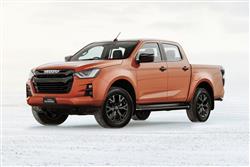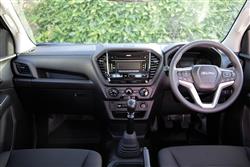EVER MORE D-PENDABLE (some text hidden) --NONE--
By Jonathan Crouch
Introductionword count: 37
The RG-series Isuzu D-Max pick-up got the first of its updates in 2023 and it's probably worth stretching at least this far if you're looking for a used version of this design. Let's take a closer look.
Modelsword count: 3
1.9 Pick-up (diesel)
Historyword count: 96
Isuzu has quite a history selling pick-ups in the UK, going back to the launch of the TF model back in 1998. RA and RT-series models followed (in 2002 and 2012) before the RG-series design arrived in 2021. This arrived in the UK some time after it debuted in other markets, so it wasn't long before Britain got this model in facelifted form, this update launched in 2023. That's what we're going to look at here. There was a further RG-series update in early 2025, but it's the 2023-2024-era D-Max models that we look at here.
What You Getword count: 720
All the visual changes which set this 2023-era facelifted GR-series D-Max apart from the original '21-era version can be found at the front, where tweaks were made to the two-tier front grille. As part of these, the Isuzu name was moved to sit above the top bar, rather than being embedded within it. And the lower bar lost the acute angles which had previously characterised its lower corners. The black grille slats below were also revised. As before, As before, most customers wanted the Double Cab body style - which was conditional for customers wanting the top 'V-Cross' 'Adventure Range' model - but Isuzu also continued to offer an 'Extended Cab' variant alongside it in the more affordable mid-level 'All-Purpose Range' (think 'back-to-front' rear doors and occasional rear seats). In the base 'Business Range', that 'Extended Cab' variant featured along with the traditional Single Cab body shape with its much longer cargo bay. As before, side steps and 18-inch alloy wheels featured on most models - though the rims were redesigned for the plusher 'All-Purpose' and 'Adventure' versions, getting a two-tone finish on the mid-range 'DL40' variant and were painted dark grey on the top 'V-Cross' derivative. Inside, there's the high-set driving position that's typical of a pick-up in this class and there's a 4.2-inch display flanking analogue dials in the redesigned instrument cluster. For plusher DL40 and V-Cross models, the centre stack gained a modern touchscreen which will be either 7 or 9-inches in size and includes 'Apple CarPlay'/'Android Auto' smartphone-mirroring. All-round visibility isn't bad for a pick-up, there's plenty of cabin storage and as part of this update, the seats became far more supportive. At the back in the Double cab, there's slightly more passenger comfort than is provided by some rival models, thanks to this 'RG'-series model's relatively generous wheelbase length, which was used to the benefit of rear-seated folk. As a result, there's a little more leg room than you might expect and decent room for head and shoulders. It's also noticeable that the seat's back rest is a little less vertically inclined than with some rivals, which gives noticeably greater comfort on longer journeys. One nice touch is the way that twin storage areas under the 60:40-split rear seat base enable you to more flexibly use the rear passenger space for packages, should you so wish. You lift a little flap on each side. Plus you can also pull down the rear seat backrest, preventing the upholstery from getting grubby when you're carrying pets or packages. What about the load bay area? Well if you've used a D-Max in the past, the first thing you'll notice on most versions of the 'RG' design is that Isuzu includes a damper to the tailgate, so it doesn't fall open as soon as you release it. The thing is still pretty heavy to lift though. A big step is moulded into the bumper so that reaching in is a little easier; and 30mm of extra depth was added to the cargo bay compared with the previous 'RT' model - though the resulting 465mm depth figure was still comfortably the least accommodating in the class from this period. The 1,495mm load bay length of the Double Cab model was also bettered in period by the Toyota Hilux (1,525mm), the long wheelbase SsangYong Musso (1,600mm) and the Ford Ranger (1,613mm). Obviously, you'll gain more load bay length with the alternative two D-Max body shapes; the Extended Cab offers 1,805mm and the Single Cab has 2,315mm. As with this Isuzu's three key segment rivals, there's enough load bay width (1,530mm) to take a standard UK-sized pallet lengthways between the wheel arch intrusions. And this area meets the usual pick-up class qualification that it should be able to take over a tonne of weight; with the top Double Cab auto model, the figure is up to 1,070kgs; you'll be able to take a fraction more if you choose a manual gearbox or an Extended Cab model - and the figure for the Single Cab is up at 1,205kgs. In our 'Driving Experience' section, we briefed you on this D-Max's class-competitive 3.5-tonned braked towing capacity; but noted the reduction that would be necessary to that figure were the load bay to be fully weighted-up (an issue also with the Ranger and the Hilux).
To see the full road test text contact us on 0330 0020 227
Pictures (high res disabled)
.jpg)
.jpg)
|
.jpg)
|
.jpg)
| |||
.jpg)
|
.jpg)
|
.jpg)
| |||

|
.jpg)
|

|
Scoring (subset of scores)
Category: Pick-Ups
| Performance | |
| Handling | |
| Comfort | |
| Space | |
| Styling, Build, Value, Equipment, Depreciation, Handling, Insurance and Total scores are available with our full data feed. | |



